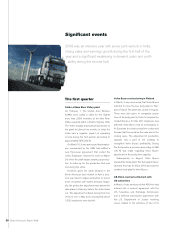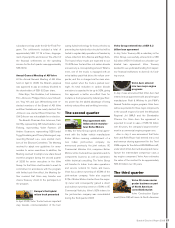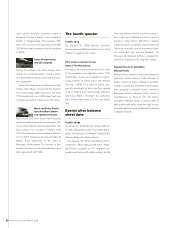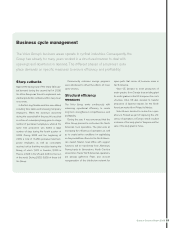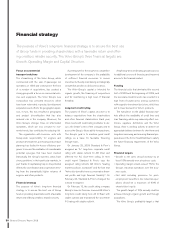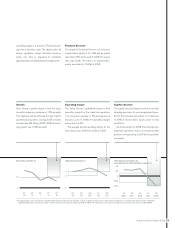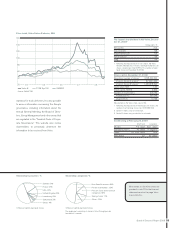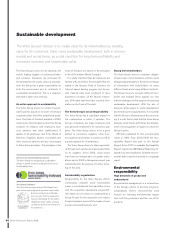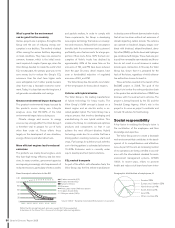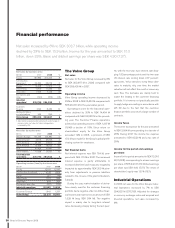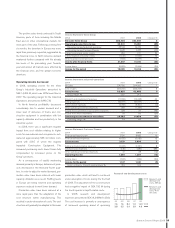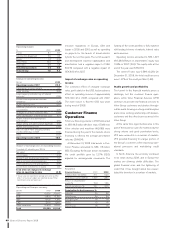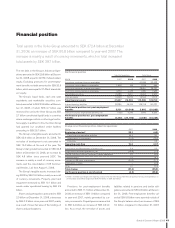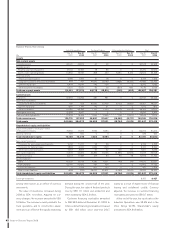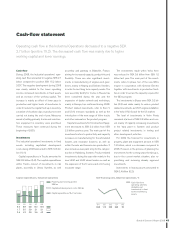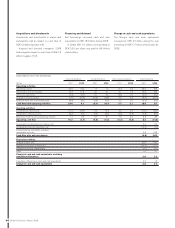Volvo 2008 Annual Report Download - page 40
Download and view the complete annual report
Please find page 40 of the 2008 Volvo annual report below. You can navigate through the pages in the report by either clicking on the pages listed below, or by using the keyword search tool below to find specific information within the annual report.
2000
0
20
60
40
80
120
100
Within the EU all road transport emissions except for CO2 are expected
to decrease in the future. This is the result of stringent emission regulations.
Source: ACEA – European Automobile Manufaturers' Association.
1995 2005
Solvents (VOCs)
Particulate matter (PM) from diesels
Sulphur dioxide (SO2
)
Carbon dioxide (CO2
)
Carbon monoxide (CO)
Nitrogen oxides (NOx)
Benzene
2010 2015 2020
Road transport emissions in the EU Geographic distribution of employees, %
Sweden 28%
Europe, excl. Sweden 32%
North America 14%
South America 4%
Asia 19%
Other countries 3%
What's good for the environment
can be good for the economy
Various projects are in progress throughout the
Group with the aim of reducing energy con-
sumption in our facilities. The method of attack
differs among the various facilities, depending
on local conditions. They have one element in
common, however, which is the initial invest-
ment required. A couple of years ago, when the
Volvo Group decided to create the world’s fi rst
CO2-neutral plant, the primary goal was not to
save money but to reduce the Group’s CO2
emissions. Over the short term higher costs
were anticipated, but it rather quickly became
clear that it was a favorable economic invest-
ment. Today, it is clear that over the long term, it
will generate considerable cost savings.
Greatest environmental impact during use
The greatest environmental impact caused by
the products occurs during use. Lifecycle
analyses show that 80–90% of the total
environmental impact arises during use.
Climate change and access to energy
sources may strongly affect the Volvo Group. It
is therefore vital to prepare for use of fuels
other than crude oil. These efforts focus
largely on the development of new drivelines,
energy effi ciency and alternative fuels.
More effi cient engines lead to reduced
emissions
The products use mainly diesel engines, since
they have high energy effi ciency and low emis-
sions. In many countries, government agencies
are imposing increasingly strict requirements of
reduced emissions, particularly of nitrous oxides
and particle matters. In order to comply with
these requirements, the Group is developing
new engine technology that reduces consump-
tion and emissions. Reduced fuel consumption
benefi ts both the environment and customers’
profi tability, since fuel accounts for a large pro-
portion of their costs. Since 1975, the fuel con-
sumption of Volvo’s trucks has declined by
approximately 40% at the same time as the
emissions of NOx and PM have been reduced.
Over the past 30 years, diesel engines have
seen a hundredfold reduction of regulated
emissions of NOx and PM.
The Volvo Group has the world’s most state-
of-the-art program for heavy diesel engines.
Vehicles with hybrid driveline
The Volvo Group is the leading manufacturer
of hybrid technology for heavy trucks. The
Volvo Group’s I-SAM concept is based on a
diesel engine and an electric motor, a so-
called parallel hybrid. The Volvo Group has a
unique process that involves developing and
manufacturing its own hybrid solution. This
enables the Group to coordinate and optimize
products and components so that it can
achieve the most effi cient driveline. Hybrid
technology works best in a vehicle that has a
driving pattern involving numerous starts and
stops. Fuel savings for a delivery truck with this
sort of driving pattern is estimated at between
15–20%. Extensive work is currently under
way to develop and test hybrid solutions.
CO2-neutral transports
As part of the efforts with alternative fuels, the
Volvo Group was the fi rst vehicle manufacturer
to develop seven different demonstration trucks
that all can be driven without net emissions of
climate-impacting carbon dioxide. The vehicles
can operate on biodiesel, biogas, biogas com-
bined with biodiesel, ethanol/methanol, dime-
thyl ether (DME), synthetic diesel and hydrogen
gas combined with biogas. These fuels are pro-
duced from renewable raw materials and there-
fore do not result in a net increase in carbon
dioxide upon combustion. In this way, the Volvo
Group has shown that it is prepared for the
fuels of the future, regardless of which alterna-
tive authorities choose to invest in.
These activities resulted in the launch of the
BioDME project in 2008. The goal of the
project is to involve the entire production chain
in the production and distribution of DME from
biomass until it is used as fuel in vehicles. The
project is being fi nanced by the EU and the
Swedish Energy Agency. Volvo’s role in the
project is to serve as project coordinator and
to build 14 vehicles for fi eld-testing.
Social responsibility
A key factor in realizing the Group’s vision is
the contribution of the employees and their
knowledge and expertise.
The Volvo Group aims to create a favorable
work environment that contributes to the devel-
opment of its competitiveness and attractive-
ness. As part of this aim, an increasing number
of its operations are being certifi ed in accord-
ance with the international standard for work-
environment management systems, OHSAS
18001. In recent years, efforts to promote
health and reduce sick leave have been inten-
36 Board of Directors’ Report 2008


